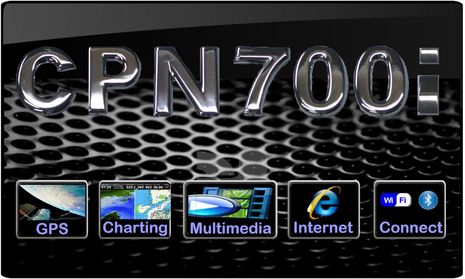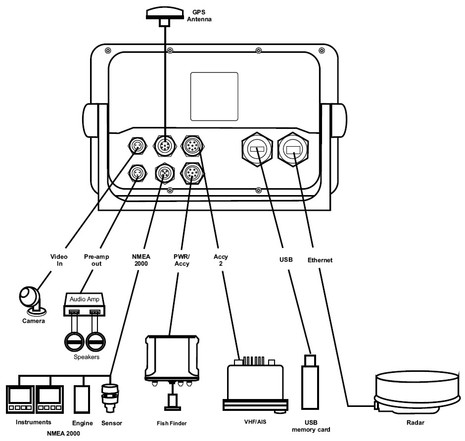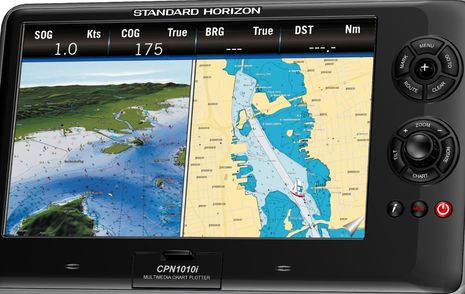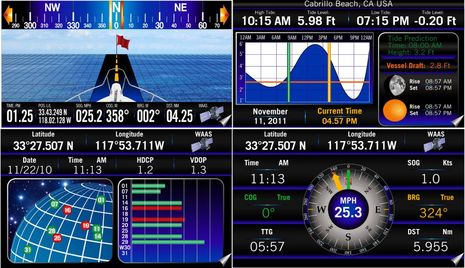Standard Horizon CPN Series, the first Internet MFDs?
At first glance Standard Horizon’s new CPN may look like a fairly standard multifunction display, but note the “turn page” screen graphic at lower right, the small (but purportedly powerful sounding) stereo speakers, and the “Multimedia Chart Plotter” designation. The 7- and 10-inch CPNs have touch screens not only to help manage charting, optional radar, and so forth but also to select audio and video entertainment stored on front or back connected USB sources, or streaming over WiFi. And, yes, there is a Web browser in there too!

In fact, I think what we’re seeing here are the first MFDs that are also capable Internet appliances. For instance, they have Bluetooth so you can use a wireless keyboard and/or mouse instead of the touch screen to manage email. And there’s even a bit of integration between the nav and web abilities: Apparently weather data from Baron’s new QuikLink internet service — which looked great in a demo I saw in Fort Lauderdale — can overlay on a CPN’s charts.
The $1,500 CPN700i and $2,300 CPN1010i can also work with an optional XM Satellite Weather receiver (which delivers Baron data too), and they have a few other big system features that Standard hasn’t offered before. The Ethernet port seen in the 700i connection diagram below, for example, can also network to a second CPN. And, look, there’s a NMEA 2000 port. But that port isn’t even mentioned in the initial CPN spec sheet because in fact it won’t be functional until a software revision planned for mid summer. The company also cautioned me that the screen shots seen above and below are prototypes, and may change…
 Overall, it seems like Standard Horizon is trying hard not to over hype this unique design, and that may be largely because they’re still learning what it can and can not do themselves. After all, this is not a full fledged PC with a lot of extra memory and drive space. According to product manager Scott Iverson it may even turn out that Web browsing will only be possible when the machine is not in navigation mode (though I don’t think many boaters would find that a major restriction).
Overall, it seems like Standard Horizon is trying hard not to over hype this unique design, and that may be largely because they’re still learning what it can and can not do themselves. After all, this is not a full fledged PC with a lot of extra memory and drive space. According to product manager Scott Iverson it may even turn out that Web browsing will only be possible when the machine is not in navigation mode (though I don’t think many boaters would find that a major restriction).
I appreciate Standard’s caution and think we should be careful with our expectations, but isn’t the CPN Series an interesting development? For the specs and description as revealed so far you can download the whole 2011 products announcement here (595 KB). Tell us what you think, please.















The CPNs will come with same huge built-in chart portfolio as all of Standard’s new plotters, but they will also be able to display C-Map 4D card bundles, which I saw a bit of, and liked, last week on the Geonav demo trip.
Way, way cool.
Quite noteworthy that the browser icon is that of Internet Explorer, hinting that this MFD is running Windows Embedded. I know that Furuno NN3D is running Windows Embedded, probably XP. Navico’s NES/HDS is running Linux.
Giving the users access to the browser is the next step towards making MFDs just a “marinized PC”. I’m in doubt as to whether this is a good development. My current MFD is so much more reliable than a PC…
Also, prices seem very competitive… Bring it (competition) on!
Ben;
Any idea what radar scanners will be compatible? MDS series + an ethernet conversion box, or something else?
Chris
Love it!! N2K, Wifi, Entertainment and Navigation. I like this future.
I agree with Kees though that reliability needs to be held high, that said my laptop with all the current XP updates from Microsoft has not even hiccuped for two years.
Let’s not get overboard on some things; the CPN700i will have a 7” 800 x 480 resolution and the CPN1010 a 10” 1024 x 600 resolution. That means that the 2nd and 3rd pictures that Ben has shown are not going to be what you’ll see on the real-life products as those have (as good as) 1366×768 pixel resolution. In other words, some marketing fluff is being applied here.
Although I understand that market economics drive the trend towards “wide” 16×10 screens I much prefer 4×3 screens… For navigation purposes, square would be even nicer. Alas, there is no market for those. Better get used to 16×10 or 16×9.
The “wide” screen proportions are a mixed blessing. It helps with side by side windows, but really compromises the full screen chart and radar display for those of us not in the habit of running our boats sideways.
It would be really nice to be able to download charts and data at the dock via wifi and get sea temp charts without a weather module, for example.
Still waiting for that GX2xxx VHF that has a full AIS B transceiver embedded in it.
Maybe it’s just me but why would I want an Internet link to my chartplotter very few people can afford it underway and surely in a marina you wsnt a laptop
Confused.
Dave
In the picture of the CPN 1010i the MOB button is right between two standard, non-emergency buttons and vulnerable to accidental activation. If this product is interfaced with a VHF/DSC radio, as shown in the diagram, we might see many false alarm MOB transmissions on DSC. This is especially possible at night when bouncing around in a seaway. If it’s not too late to make changes I suggest the MOB button be located away from the normal controls.
Richard, I think the CPNs and the other SH plotters will plot DSC calls, send GPS to a VHF, and maybe more, but I’ve never heard of a plotter initiating a DSC alert.
Kees, I think the CPNs are running Windows CE.
I’ll get excited when Apple starts making MFD’s and does the job 10x better than anyone else. The iPad, with all of its limitations (and not even being designed for marine use), is already better than many dedicated plotters. Need backups? keep a couple spare iPads, they’re dirt cheap compared to proprietary gear.
This sure looks like the Swiss Army knife of MFD’s, but I wonder why they didn’t add email and G3 or 4 capability. Everything else is here.
But seriously, Standard Horizons, and all other MFD manufacturers problem is the 800 pound gorilla in the room (iPad) and the soon to be a second 800 pound gorilla (Blackberry).
Is there any future for MFD’s, even cool ones like this?
I purchased a Furuno MFD8 on the theory that it would be more reliable than a PC. Now I find that it crashes just like a PC (on position PGN’s no less), but is much slower and more limited in hardware, and (manufacturer imposed) software. The fact is that as it is not economically possible to write a new marine operating system from scratch, all MFD’s are, and will continued to be marinized PC’s, both in terms of hardware, and specialized software. At their core is Windows (Furuno), or Linux (Simrad/B&G), or flavors thereof (Mac-Darwin/Android).
I’m not suggesting that’s a bad thing, just waiting for the day that, like smart phones, marine manufacturers open up their PC’s to others to write marine “apps” on their open MFD’s. But I’m not holding my breath.
Cheers,
Noel
There must be something untoward in your Furuno NavNet setup. I have had a system with three MFDs for three years (some of the very first units delivered). It did freeze up and crash pretty often when I first got it but since the first big software update back in late 2008, I don’t recall it crashing even once over many hundreds of hours of use. I have two NMEA2000 GPS sensors transmitting position data PGNs on the network. Furuno tech support is extremely responsive in my experience. If you are having crashes, they should be able to identify the cause. I had an issue early on with a PB100 and the Furuno tech actually replicated my entire system on his bench to help diagnose the problem.
One of the advantages that an established supplier in the marine market has is in the vital peripheral components such as the radar and sounder. Just look at how long it took Garmin to produce decent network radar and sounder modules that could approach the performance of the “traditional” marine electronics manufacturers such as Furuno and Simrad. I think it would take PC suppliers a long time to get everything right.
The idea of Apple developing marine MFDs is completely laughable. Estimated 2011 sales for iPads alone is 15 billion dollars, while the entire global recreational marine electronics market is something like 1.5 billion, and that’s everything from Walmart fishfinders to satellite tv systems.
And I doubt that iPads or any other consumer electronics are going to become primary navigation devices on many boats in the near future. But they will get ubiquitous as secondary devices, and I suspect that the marine electronics that play nicely with them will get an edge.
Bravo, Standard Horizon. you have opened the door to universal integration. This is the next logical step away from the “Tower of Babel” status of previous marine electronics. This is also another nail in the coffin of proprietary systems. Now if someone could just come up with a way to pump high speed video across an existing N2K backbone….
Ben,
I didn’t intend to suggest that Apple would directly enter the marine market, only that all MFD’s are based on well known operating system kernels (mostly Windows/Linux) not written by the MFD manufacturer. In essence, they are PC’s, just closed PC’s.
Third parties could and would write marine “apps” for those MFD’s, like Navionics has for iPhone(Darwin)/Android(Linux), if the MFD manufacturers allowed it, like Apple, Microsoft, and Google do. Just like the smart-phone market, I think the marine electronics market would grow much faster if they did.
Cheers,
Noel
Right, Noel; it was Trev that suggested that.
As for the MFD app idea, I think one way we’ll see that happen is the Plotter Sync feature coming soon to Navionics apps and Raymarine MFDs. I’ve seen it demoed and it was completely transparent; create a route on a iThing and it appeared on the MFD, and vice versa. And, plaudits to Raymarine, they see how the WiFi connection could also put boat sensor info onto apps phones/pads and say they’ll support that. And Navionics wants to see all the manufactures support Plotter Sync.
But it’s not yet clear that the CPN Series has the horsepower to do Plotter Sync let alone more complex apps. It seems like SH already packed a lot into a fairly modest price point.
I think Garmin has been running a version of embedded (and inaccessible) MS XP in MFDs for quite some time now. Since Win CE has not found as much acceptance, I would be surprised to hear that SH is using it; even Android is a better choice. In any event, saying that makes them all PCs is like saying a City Bus is a Minivan because it seats six + and stops at red lights!
Geeez Ben! I start to complain about not having N2K ports, etc. and they drop this on me. Anyone want to buy a CP500 cheap? I doubt my wife will get me one for Christmas… good think I have birthday before launch!
When I shopped for my new system I did not look at Furuno because of the Windows layer.
I bought Simrad,my understanding is a Linux system has one less layer of code than Windows does.(Please correct me if this is wrong.)
I do know I have a Macbook running snow leopard ,and a netbook running Windows 7.
The Macbook has never crashed/frozen in the year I have had it.
The netbook has frozen and even told me it experienced a “blue screen moment”
The Standard Horizon running IE is also open to all internet viruses.
When I was wiring big yachts the Nav computer never had live access to the Internet,that was the rule.
Ben, seeing they are networkable, when is the tiny screen coming (5″ i.e. CPN500i – aka CP190) for the cockpit, even the navpod? Other questions, since we know the SH folks read this site, will it accept N2K AIS info, will it come with built in AIS? When are the N2K transducers coming?
Again… CP500 for sale cheap!
That’s only one step towards a world of smart devices “always connected”. Everything will eventually be “always connected” from refrigerators to cars to street and marine navigators.
Marine electronic devices need to be open so that developers can create applications for the benefit of boaters: sailing apps as well as social apps for sailors.
If manufacturers will not open their platforms, there will be someone else starting a business company from scratch who will enter this market with a totally new open platform.
After all CPNs are just ruggedized PCs.
A ruggedized Pad would even be better.
Dream on, Marcello! Even if most consumer electronics really do evolve to an “always connected” model, marine electronics will follow quite slowly, as they wander where that connection can get really tricky. Which is why the online functions of the CPN Series are not critical to navigation.
And why would a “ruggedized Pad” be even better? Useful for some secondary applications and at-anchor time, for sure, but I think that what most boaters want at their helm is a fixed, waterproof, bright screen with marine specific one-hand button and/or touch controls and reliable connections to radar, sonar, NMEA 0183 & 2000, video, other MFDs, etc.
If those devices can also be media players and Web browsers when at anchor, and maybe even download weather and chart updates, that’s great, but it doesn’t make them “just ruggedized PCs”. In Sandy’s words, that’s “like saying a City Bus is a Minivan because it seats six + and stops at red lights”.
In fact, I think we’re going to see that the CPN Series is a pretty closed design, more an Internet appliance than a PC. And maybe for that reason less vulnerable to the PC viruses some are concerned about.
I’m afraid the minivan analogy does not fit well here. Minivans and buses haven’t changed much in the last ten years. If they had followed Moore’s Law, as have PC’s, they would carry a hundred people at a thousand miles per hour. My Android phone is more powerful than my desktop of a few years back.
For thirty years I have watched PC’s devour their competition from word processing and accounting in the early days to the recent elimination of specialized supercomputers in high definition film editing. At the high end, sailboat racing is already dominated by PC’s, not MFD’s.
http://tinyurl.com/2eaw5eq
I agree that reliable connections to marine sensors is boat specific, and wish a marinized black box N2K/0183/etc. router with Ethernet and wireless I/O was available, but I see nothing but PC’s, tablets and phones in the future for the rest of the applications.
Cheers,
Noel
I think the analogy is more about capability than change. After all, what I’d call actual ruggedized PCs and tablets have been around for a long time:
https://panbo.com/archives/2005/04/nobeltecpanasonic_wifi_display_gets_an_upgrade.html
Interestingly, they’re most seen on high-end racing sailboats. But isn’t that because the navigation and helm duties are fully split, there is no fixed spot for the navigator on deck, and the niche is so small and specialized that no manufacturer has built a dedicated MFD for it anyway (B&G Zeus possibly excepted)?
I do think that we’ll see “marinized black box N2K/0183/etc. router with Ethernet and wireless I/O” soon, but I doubt that dedicated MFDs will go away quickly.
Noel, you said “but I see nothing but PC’s, tablets and phones in the future for the rest of the applications.” I take it you mean that MFD’s will go away to be replaced by consumer-level devices. I urge you to look a little further, beyond the race markers and over the horizon. That is where the toys get tucked into their cubby holes, and experienced mariners put on their foulies and hook their tethers to jack lines.
No matter how wonderful these gadgets are, they are not built to survive cockpit conditions. Sure there are marinized computers in a variety of forms, BUT THEY COST MORE THAN MFDS. There has to be a market before ther can be comparable pricing for marinized computers, but the only pockets deep enough are found on big buck racers and Cap-n-tie gold platers. Price alone prevents their acceptance by off-shore sailors, and newbee inland lake and coastal sailors look to the experienced salt for advice on instruments, not the kid at Best Buy, or the glowing if broken english on the tablet websites.
What about bundling my Droid or my shiny new Shinzuan (sp?)superpad in a fresh baggie? I think not. When the bag splits open and my precious toy dies, (probably at the same time my cell phone range tubes) I will be looking for my old reliable, purpose-built, and not so very expensive GPS with built in charts connected via water-proof cables to proven transducers, mounted at the helm where it can be seen and used in cold driving rain, salt spray, and snow or sun-baked glare, by numb fingers and fatigued minds.
No, neither Apple or its Chinese pursuers will put in the research or certification expenses for our tiny little market. There will be tablets and multifunction pocket ballast for sailors in a very short time, but they will come from the established marine electronics manufacturers, for a very specific set of reasons: They know us. They are geared toward making a living on what we are willing to spend, and they understand why kind of misery comes to a manufacturer whose product fails in life threatening conditions.
BRAVO to Ben et al for the most INSIGHTFUL critques of a product catagory ever!!! With this po- por- ee (sp?)of “goodies” to offer from (I hope soon )the SH firm & competion rushing -in, the users will be agog over the functionality & will truly NEED the professional help of a good NMEA member to configure /install/support ongoing !!
We had better be up to the challenge ! WOW—to pitch this package to My commercial fishermen customers stews My noodle & heart !!! This is NOT simple “plug-n-play” !! The “up-grades” path seems limitless. I am excited to see this all aborning…..so SH—keep coming,but watch the price line—-“value” has it’s limits !!!
I would be interested in the WiFi specifications on the product. I don’t see an external WiFi antenna port. There could be a work around using a bridge router and then a small AP in the boat. I wonder if the unit will support WPA2? I think it’s just a mater of time before most marinas or marine facilities catering to mariners installing robust PMP WiFi systems. But with the new FCC Net Neutrality laws it has the WISP community in a state of confusion.
Bill Lentz
I shifted from Garmin to Standard Horizon several years ago as a result of both their more reasonable pricing, open policy about adding AIS, and their policy about chart availability. But the Garmin software remains slightly better than the SH.
The new CPN1010i now adds Touch-Screen capability. How useful has this proven to be in daily use? How well does it work when wearing mittens?
I agree with the comments about the limited usefulness of a wide screen, vs. a tall screen.
It would be very nice if Standard Horizon provided the software option of rotating the screen to have the display in vertical mode, rather than horizontal mode.
regards,
Harvey
“Night Heron”
“open policy about adding AIS”…I don’t understand what you mean by that, Harvey; Garmin MFDs accept AIS data from any source via NMEA 0183 or 2000.
We want more info!!!!
David, there is a bit more in this recent Panbo entry:
http://goo.gl/orfW5
and I’ll have some more about what I saw in Miami next week. But we’ll have to wait until SH finishes version 1 of the software and ships CPN units (in about 90 days) before to get a full sense of how well this hybrid idea works. Plus there are planned updates to add NMEA 2000 and Ethernet support. But consider this: given a decent WiFi connection, a CPN may be able to update itself.
Does anyone have an availability date yet for the CPN models? I need to buy a chartplotter and would prefera CPN if they are available soon.
Daniel
I’m not sure where the comments about WiFi being expensive come from? Most marinas in my part of the world provide WiFi as a customer retention tool. Most of the cellular carriers in the US also will give you WiFi AP access if you have a data plan. It is an inexpensive way for the cellular carriers to off load traffic from their 3G networks while they build their 4G networks. Even that latest 4G devices come with a WiFi connection manager. From the mid-Atlantic to NYC/Long Island area if you have broadband cable at your business or home the following cable operators Comcast/Xfinity/Time Warner/ Roadrunner/ Cox Communications will provide access codes (for business users) with up to 24 MAC adresses for your company to gain free WiFi access to many public networks for 3 simultanious users.
I wish Garmin would come out with a WiFi interface box for the higher end MFD’s. I would think those with multiple MFD’s would welcome this. As mentioned in an earlier post it would be a great way for the manufactures of MFD’s to keep the customers software updated. It could also be a sales tool to download their latest charts and marine applications. It might even be a good way to register the product’s warranty.
Bill Lentz
It’s not exactly what you’re imagining, Bill, but I will have a very interesting product announcement tomorrow morning!